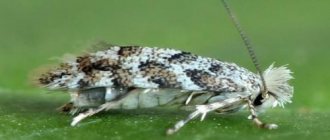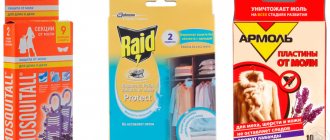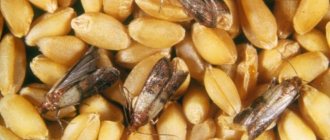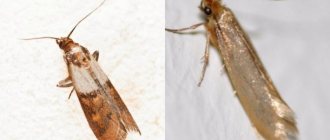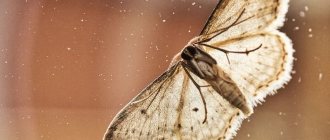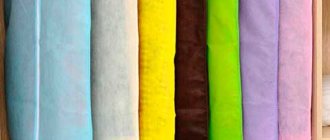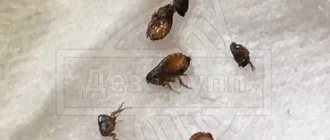- home
- Pest control
- Removing clothes moths in an apartment
- Types of moths
A moth is an insect that absorbs the substance of the stratum corneum - keratin. Such organisms are also called keratophages. But despite this, we often notice these insects crawling in the closet or flying around the house in search of woolen items. Why are they so attracted to wool? The answer is simple: at the molecular level, wool and fur contain the moth's favorite food product - keratin. Thanks to the unique environment of the stomach, which contains a lot of acid, moths easily digest keratin.
What you need to know about moths
The moth can be characterized by the following characteristics: it looks like a small butterfly of brownish-yellow, pale gray or white with a lot of silvery pollen on the wings. This insect goes through the following stages of development: the eggs hatch into larvae, then they become butterflies, and the adults, in turn, lay eggs. Moths themselves are practically harmless. You should be wary of larvae that hatch from eggs laid by butterflies in the fibers of things.
It is important to note that butterflies experience discomfort from sunlight, so they mainly live in dark places that are difficult for sunlight to penetrate - for example, in closets, closets and chests of drawers. The offspring hatched from the eggs, like butterflies, prefer to be in the dark, where it is almost impossible to detect the larvae. It should be noted that in the cozy conditions of city houses, moths are able to lay eggs all year round!
Reasons for appearance
The moth is different in that it can appear in a home where cleanliness and order are maintained. Some housewives believe that they are not to blame for the appearance of moths in the apartment. Actually this is not true. Despite cleanliness and order, these insects are attracted by completely different factors, such as the presence of freely available bulk food or the presence of knitted items made from wool and other natural ingredients. Often, housewives do not pay due attention to the process of storing these components.
Moths can enter a home:
- Through open doors and windows.
- From the entrance, if they live in other apartments.
- With used furniture.
- Through cracks, air vents.
- With used things.
- With food purchased in a supermarket or market.
Lifespan of a moth
This is a rather important question, considering that insects actively eat clothing and furniture.
Before the onset of puberty, the individual goes through two stages of development: egg and larva. At an air temperature of 20 degrees Celsius, the laid egg takes two weeks to develop. The larval development period varies from three to ten months. At this time, the larvae form a cocoon around themselves from the nutrient material, in which they develop further.
After acquiring wings, the individual does not live very long - only 2-4 weeks. This period varies depending on the type of parasite. During these weeks, individuals are not particularly mobile and fly mainly in the dark, since the wings are poorly developed, which makes the insects very vulnerable.
If you add up the three periods of time during which the life of a moth occurs, you get a very impressive period of time during which the parasites do not waste time destroying interior items and wardrobe items.
Poodle
The appearance of these insects is surprising and even captivating. They are quite large, reminiscent of a snow-white fluffy poodle, which is made in miniature.
So, these mysterious insects were discovered in Venezuela only in 2009. It is very difficult to meet them in natural conditions. They have not yet been studied and remain a mystery to researchers and scientists.
What types of moths are there?
The most common types found in the home are:
Fur moth
The fur moth is an individual that has shiny dark yellow wings, with dark specks on the wings. The lower layer of the wings differs in color from the outer ones: they are light gray. The wingspan ranges from fourteen to fifteen millimeters. The fur moth prefers to feed on clothing made from natural materials. The hatching larvae look like worms, have white, almost transparent skin, through which the contents of their stomach can be seen, and eight very short abdominal legs. The larvae prefer to consume fur products.
Clothes moth
The clothes moth is larger in size than the fur moth; its wingspan is up to twenty-two millimeters. She also has two pairs of wings, which are purple at the very base, turning yellow towards the middle, with a small brown spot at the very top. The clothes moth larva is covered with a small white fluff and is similar in appearance to the coat moth larva. But, unlike their relatives, clothes moth larvae prefer to huddle in folds or inside woolen material, eating fairly large spaces of material that are invisible from the outside at first glance. The larvae are kept on clothing by a stationary cover.
Furniture moth
Furniture moth - a representative of this species has shiny silver-yellow wings, the head is dark yellow, and the base of the wings has a brown tint. This variety of keratophages has a significant difference from all other species and thanks to this it was declared a separate genus. This difference is the absence of oral tentacles. Furniture moth larvae destroy furniture in a unique way: first, the hair padding in the soft parts is eaten, then, closer to the pupation period, the larvae appear on the surface of the upholstery and begin to gnaw tunnels in the furniture cover. Pupation occurs on the lower surface of chairs, armchairs, sofas, and beds. In such places, a huge number of light cocoons accumulate. The period of development of larvae depends on the time of year: in winter it is five months, in summer – about two months. Pupation, as a rule, occurs towards the end of winter, that is, in February.
Clothes
As the name suggests, insects live on woven materials. They cause great damage by gnawing through large spaces in fabric products. The diet consists of wool, cotton, knitwear, and textile parts of upholstered furniture.
They have wings of a yellowish or purple hue, a wingspan of 22 mm. The larvae have cloudy white coatings. Females lay offspring in the cavities of the material.
Agricultural pests
It is better to study the enemy thoroughly so as not to get confused if you suddenly have to meet him not only in the apartment, but also in the garden! It is quite common for entire colonies to attack agricultural crops, poisoning the lives of gardeners. Let's look at several main types of moths:
grain moth
The grain moth is a species of keratophagous silvery-white with a small bright brown pattern on the fore wings. They can also be recognized by their gray belly and wings, the span of which reaches up to fifteen millimeters. Pupation occurs primarily in spring and summer. Grain moths can most often be found in barns, warehouses, granaries and other places where grain crops are stored. An individual grain moth lays up to a hundred eggs directly on grains: one or two eggs are glued to each grain. The female combines several grains into a kind of lump with the help of a sticky liquid secreted, similar to a web, and eats them while inside this lump of web. To move, she has to drag the entire bundle behind her. This type of moth prefers to pupate in cracks in the floor and walls. In addition to grains, moths also eat dried fruits and various seeds.
Rye moth
Rye moth - this species has a wingspan of up to thirteen millimeters. The hind wings are dark yellow, with a brownish edging. The most common rye moth is found in central Russia. Individuals prefer to lay eggs towards the end of summer on wild cereals and on emerging winter crops. The larva eats the core of the stem and spends the whole winter in it. Pupation of rye moth larvae occurs closer to mid-summer.
Ermine
They are street species and differ in external characteristics. The size of the body is about 2 cm, the wingspan is 16-22 mm. The front wings have a snow-white color and a silvery tint; black spots can be seen on them.
On the head there are thread-like antennae that resemble a crest. Their diet consists of useful plants; they prefer bird cherry, apple trees, etc. Bird cherry is a favorite food, so they were given another name - bird cherry moth.
Potato moth
This representative of parasites does not have the most attractive appearance: the wings are dirty gray in color and dotted with dark spots.
But in the larval stage, the individual is more pleasant to look at and has a light green (sometimes pinkish) color.
Having fledged, the individual acquires long mustaches and a body length of up to seven millimeters with folded wings. Life in this stage lasts only a few days.
The unprepossessing appearance appeared for a reason: it helps the pest remain unnoticed, even if you look at it, as they say, “point-blank.”
Females lay eggs on the surface of leaves on the underside. The larvae that hatch after some time develop very quickly.
As the name suggests, potato plants suffer from parasites. Individuals can remain alive until the temperature drops to 4 degrees. But individual individuals can climb into the tubers themselves and continue to exist there. Potato moths wait out serious cold weather, as a rule, in barns, which have enough seed potatoes for food. With the same potatoes, parasites re-enter the soil in the spring.
Methods of disposal
If there are moths in your apartment, there are several ways to get rid of them:
- Special aerosol. This remedy will help if you find the place where it lives and treat it. After using the aerosol, you need to leave the house for several hours, and after returning, do a wet cleaning.
- Velcro or moth traps. They are hung in the kitchen or near cabinets, the moth sticks and dies. Often they are simple paper, with a sticky backing, and are attached to inconspicuous areas of the cabinet.
- Pills . They can be placed in areas where moths are likely to appear.
- Folk remedies . This includes various repellent compositions of herbs, washing with soap or vinegar.
- To combat agricultural moths, indoor treatments are carried out; infected grain is heated or frozen. The room must be disinfected and dried well.
What are the best anti-moth products?
ChemicalFolk
Vegetables in which moths have infested are also treated. You can use chemicals or traditional methods that last longer and are more effective.
Any moth does not like strong movements and temperature fluctuations. Therefore, temperature treatment helps at home. Moreover, it tolerates both frost and heat equally poorly.
Cabbage moth
This parasite causes damage to cruciferous crops. Externally it differs from other types of moths: the body is oblong in shape and light green in color, covered with small hairs. You can easily confuse an insect with a straw if it folds its wings. The wings themselves are framed with fringe at the edges. The larvae have characteristic brown heads.
In terms of activity, cabbage pests are no different from the rest: they are inactive, fly poorly, and rarely move very far from the place where the cocoon is left. Parasites lead a solitary lifestyle and rarely gather in groups. On a leaf you can see one, maximum two individuals.
It is easy to detect and identify the eggs of the parasite: they are elongated and very small. The egg is up to 0.5 millimeters long and only 0.2 millimeters wide. The green color perfectly camouflages them on the foliage.
Insecticides
Modern drugs have different forms and principles of use.
Aerosols are undoubtedly the most effective option for getting rid of food moths in the kitchen. But, at the same time, they require the most serious precautions. Before using them, you must remove all food from the premises, and also take family members and pets outside to avoid poisoning.
After a certain period of time required for exposure to active substances, you should ventilate the room and wash all surfaces where the toxic mixture sprayed in the air could settle. Combat and Raptor do an excellent job of repelling food moths.
Flat plates for a special fumigator device are also an effective remedy for food moths, since they act on adults and larvae. The plates are inserted into the device, which, heating up when plugged in, sprays a substance toxic to the pest. Solid balls and crystals also release toxic substances, which kill larvae and adult moths.
food moth
It parasitizes inside products whose storage conditions have been violated. These are mainly stocks of cereals and groceries in barns. Parasites also find food for themselves in the wild: nuts and crop fruits become prey. For this reason, food pests can often be seen in steppe and forest-steppe areas.
It is curious that this type of moth is not able to cause harm to furniture and clothing, since it can only consume cereals, flour, sugar, dried fruits and berries. Appearance: body length with folded wings is eight millimeters. The discreet color makes the parasite almost invisible.
The caterpillars have a pinkish or light yellow color and a smooth body. Ideal conditions for development are: temperature up to +25 degrees, humidity up to 50%. All life stages of an individual take no more than six weeks.
Prevention measures
There are a number of necessary requirements that will help keep your belongings and products safe and sound.
- When purchasing groceries, pay attention to the condition of cereals, flour, dried fruits, and herbs.
- Keep food in the house in closed jars or bags soaked in salt water.
- It is recommended to ventilate kitchen cabinets frequently, wipe the shelves with vinegar, and place lavender or orange peels on them.
- Observe the shelf life of products, especially nuts and dried fruits, as moths often infest them.
- Woolen and fur items should be kept clean, and any deterrents should be placed in the closet.
- When purchasing, carefully inspect for damage or moth larvae. It is important to regularly ventilate and inspect things.
- When preventing agricultural moths, premises are ventilated and treated before storing a new crop.
Chestnut moth
The foliage of maple and horse chestnut suffers from it. After spending the entire winter in the pupal state, adult insects emerge with the first warmth. Reproduction processes soon begin, which end with the appearance of new offspring within a couple of weeks. The young growth immediately clings to fresh foliage. This causes early leaf fall and tree death.
The destructive activity of the parasites can be seen by uneven orange spots on the leaves.
Oral organ
Fruit and house moths have features similar to butterflies. But there are also several distinctive parameters. Thus, the pests lack a proboscis, which butterflies use to extract nectar from vegetation. Since adult insects do not feed, their offspring are of interest. The larvae have a special structure of the oral apparatus. Due to the fact that they have powerful jaws, they easily bite through seeds, grains, vegetation and natural products. After the larvae develop into adults, they stop eating. This also provokes the rapid death of pests.
Difficulties in killing moths
The shelves of hardware stores are filled with insect repellents. However, modern pests can extremely quickly adapt to what they are trying to poison them with. This complicates the disinfestation procedure. You have to change medications regularly. And despite all this, final victory rarely comes.
In view of this, it is easier to take care of preventing the appearance of pests. Preventive measures will vary depending on the type of moth. Recommendations on the algorithm of actions in your situation should be obtained from specialists.
Folk methods of struggle
The use of ancient methods of pest control is based on the fact that moths are repelled by pungent odors. Therefore, to protect food supplies they often use:
- garlic;
- laurel leaf;
- tobacco;
- citrus peels;
- aromatic herbs and spices.
Fragrant leaves of rosemary, mint, lavender, as well as cloves, allspice, and bay leaves are placed in cabinets and containers with bulk products.
Periodically, it is recommended to wash grocery storage areas with diluted vinegar.
Apple
A small moth with a fairly bright color. They have snow-white wings with black spots. This pest brings great trouble to gardeners. They are active during periods of apple flowering and fruit ripening.
They infect foliage and spin webs. Eggs are laid in the bark; the female lays up to 65 eggs at a time. It is the larvae that pose the greatest danger; adult moths do not have a proboscis for feeding. Large populations can destroy entire gardens.
